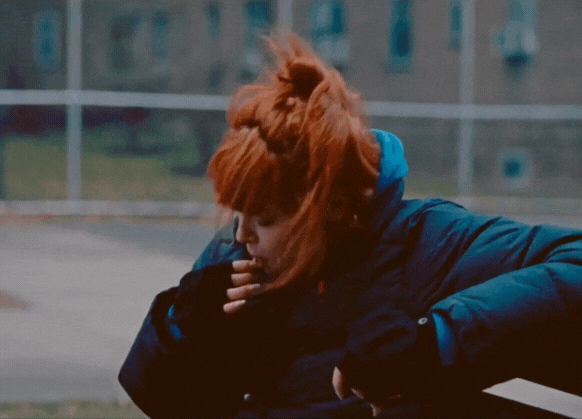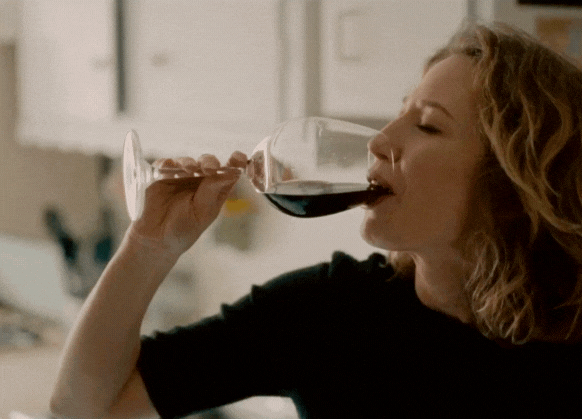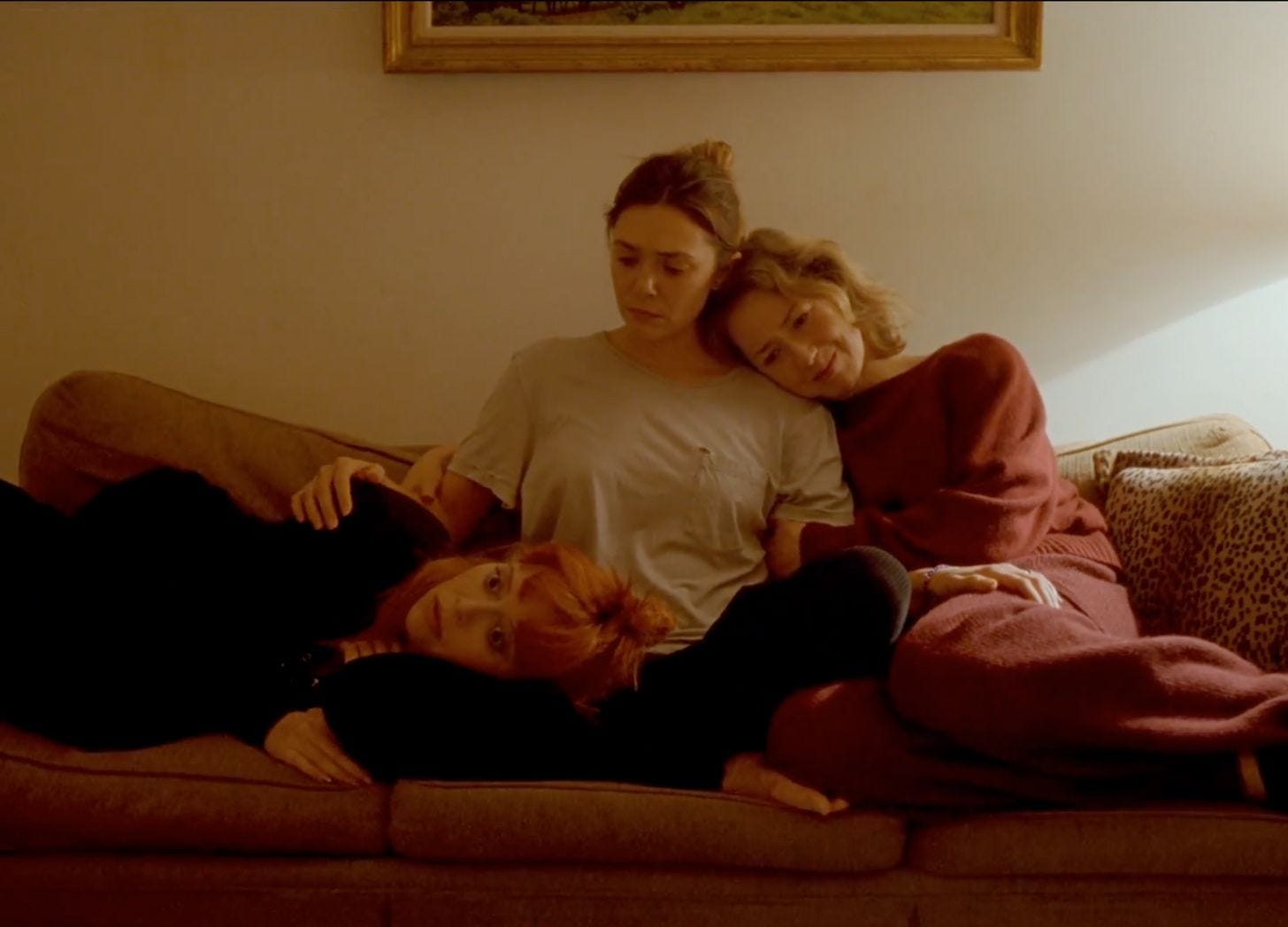If you’re new here, read this quick primer on the Story Energies, a new way to talk about storytelling.
In His Three Daughters, three sisters ensconce themselves in their childhood apartment to share their dad’s final few days of home-hospice care, and they’re determined to get along…
Things from the past don’t matter… if there are things to work out they can wait… So how, about forty-five minutes later, do they end up here?
… and how will they manage to pull themselves together before their dad runs out of time?
To try to understand how this story is working, let’s look at the different Energies at play.
[If you really hate spoilers, go watch this film now on Netflix, and come back here once you’re done.]
They may be sisters, but it’s clear from the start that these three don’t have much in common.
Rachel (Natasha Lyonne) loves marijuana—she spends almost every scene either skinning up or getting high. As we get to know her, we understand that this penchant reflects her general inclination to hang back. She prefers to watch the sports she’s gambled on than to get dragged into arguments with her sisters, and while the other two are taking shifts sitting with their dad, she refuses to go into his room.
Katie (Carrie Coon) loves red wine—once she pops her first cork, she spends the rest of the film draining glasses, or nursing mugs of coffee in the mornings. She’s immediately on Rachel’s case for smoking in the apartment, and for not having the refrigerator stocked; she cooks the meals, drafts the obituary, and hunts down a doctor to sign a DNR; she’s high-achieving, she needs to be in charge, and she expects everyone to see the world the way she does.
And Christina (Elizabeth Olsen)? Her thing is that she has no vices. She invites the others to sing with her to their dad, she tries to make peace between her sisters, she misses her three-year-old daughter because she loves her so much. She seems to only want everyone else to be as happy as they can be, all things considered.
Her other thing, that her sisters mock her for, is that she loves the Grateful Dead. But even that, she says, is often misunderstood…
Further complicating their dynamic is the backstory of how their family was formed. Katie (Coon) and Christina (Olsen) were born to the same birth parents, several years apart. Then their mom died, and their dad married again, and the new wife’s daughter—Rachel (Lyonne)—was about the same age as Katie. So although Rachel and Katie are not blood-related, they grew up within grasping range of each other’s throats, while Christina followed, adrift, a few years behind them.
And although Rachel was born another man’s daughter, and despite (or perhaps because of?) her stoner, reality-avoiding proclivities, she’s the one who has been living with their dad in this rent-controlled apartment, chopping his apples and organising his pills. Katie lives half an hour away, but rarely visits from her busy life. Christina is again cut off, all the way across the country with her husband and young daughter in California.
All these differences between the sisters, in their temperaments and their histories, charge the set-up with immense Potential Energy. Before anyone says or does anything, there’s Story here, waiting.
With siblings generally, and with sisters, perhaps, especially, shit is personal. Annoying stuff, like someone smoking weed indoors, or like someone telling you to go smoke outside, when it’s your sister can become extremely aggravating and/or soul-squeezingly oppressive. The bond makes things matter more, in a bad way.
Under normal circumstances, especially after that blow-out row, Katie and Christina would likely return to their own families, and the sisters might not see each other again for at least a few months. (Even in these circumstances, Katie packs her suitcase.) But they all do have one thing in common: they love their dad, and those father-daughter bonds are strong enough to keep them trapped in this apartment.
So they stay. And they start to feel bad about the mean things they said to each other. They open up, a little, to each other’s points of view. They begin to crave, in earnest this time, a way to get along. We often hear that hate can spring from love between romantic partners, and something similar is often true for sisters: from enmity, a deep affection. When you grow up with someone, regardless of whether or not you are blood-related, and even if you resist it at every turn at the time, a bond will inevitably form.
Magnetic Energy can be both positive and negative, often with equal force. Their love for their dad is also making them bereft and terrified, because he’s leaving. And when things get really heavy, it becomes natural for his daughters to seek solace in each other.
Even though most of this story takes place within the walls of an apartment, New York City is there in the background, exerting itself. (This friendly-gruff no-bullshit vibe might be one reason why Christina moved to California?)
And superimposed onto the NYC apartment is the world of home hospice care, with its own rules of how things work, and how people should behave, that the sisters need to navigate.
This Gravitational Energy exerts itself on the sisters in various ways. First, this gives them things like the DNR to fight about. Later, it offers them things to unite against, like the hospice aides, and things to do together, like finish the eulogy.
This story, about waiting around in a smallish apartment for an unconscious man to slowly expire, has naturally low levels of Kinetic Energy. But when things are quiet, a slammed door feels very loud. When the sisters jostle and scream at each other (see that clip above), it’s shocking. And when their dad stands up out of bed and walks, within a whirlwind of their scurrying assistance, into the living room, it’s breathtakingly momentous. Movement, like everything in storytelling, is relative.
There’s tension between the sisters from the first scene (see first clip), that gets so tight they all snap (see second clip). Meanwhile, even though they all know their dad is going to die, and even though, on some level, they want him to die, for the relief that will bring, on another level they still really really don’t want him to die. At several moments during the film, something happens—his breathing changes, or the hospice aide hurries out of his room—and that low-lying tension becomes suddenly taut and quivering, before it relaxes again when they realise that he’s not dying now.
But he is dying, soon. A clock is started in that first scene, and though his death is inevitable, and unsurprising, the story builds inexorably towards that climactic moment…
… which unleashes a surge of Electrical Energy, as all those bottled-up emotions from the past few days—from the past few decades!—are released into the room. It’s really sad! and yet it’s happy, too! It’s overwhelming. It’s love.
A movie’s shots and editing (and its music, its costumes, its sets, its props) are its words and sentences, and the stylish patience of the filmmaking certainly adds to the story’s power.
And there are also the literal words and sentences the characters speak to each other. In that climax, their dad, Vincent (Jay O. Sanders), receives through the magic of cinema the chance to make a speech to his daughters—about how he loves them, and how they love each other… “It’s just love that I want you to know about. Something that fundamentally changed me, made me who I am.” It’s all rather rousing.
This move made by writer/director Azazel Jacobs to step outside the conventional realism we’d learnt to expect from the film by having Vincent rip out his tubes, grab a beer from the kitchen, and make that speech (even as, we come to understand, he is quietly dying in his chair), is a risky one.
The Story Energies work best when they combine to add ‘heat’ to a narrative, to generate a flow that carries us somewhere surprising and wonderful. Breaking the story’s own rules like this feels less like an organic, inevitable turn for the story to take, and more like an authorial intrusion onto it.
And yet, for me at least, the risk comes off, and I think this is because, just before Vincent stands up, the story had already turned molten. Rachel had dropped her hostile defences, Katie had apologised for not being there to help more, Christina had seized that moment to lead them all, for the first time, into their dad’s room, together. And those arguments Vincent makes about the sisters’ love for each other had already been made by the story. This is why I believed them. So this intrusion of magic manages to elevate the drama, and underline the story’s meaning, while staying true to everything that had happened up to this point. I think that’s pretty awesome.
So what can we learn from His Three Daughters? What advice can we take forward into our own storytelling?
Lots of things, I hope! But here’s two gems:
To charge our stories with Potential by making our characters (in their temperaments and their histories) very different from one another. And by trapping those characters in a horrible situation. And by making them share deep-rooted bonds, like sisterhood.
And then, to trust that potential, trust the inherent conflict and drama that’s already present from the beginning, without feeling the need to add lots of extras to your story as it unfolds. Look closely at what you’ve got, see where lies its beating heart, and focus on that.
Because this story doesn’t just feature sisters fighting. It is about the fighting. From that opening scene, that repulsion is there between the sisters, and the opposing attraction is also present, beneath the surface: that need to connect—like the fans at Grateful Dead shows—to relate, to care, to look out for each other.
The movie has many tender, funny, nuanced, memorable moments, and that strikingly ambitious ending. But at its heart, it is a simple story, about the bonds these three women share as their dad is dying. And about how they need to forgive each other, so that they can hold each other, and shoulder their grief together.
To discover and explore everything this new approach has to offer, sign up for 60 days of free, full access to all Story Energies content as we get up and running.
You can watch His Three Daughters on Netflix.




















I haven’t seen the film but I love the way you’re talking about Story Energies. I’m hooked!